Searching from the Search Screen
You can specify a search condition to search from the Search Screen. Searches from the Search Screen search the property information of folders and documents. You can also enter search keywords to search for as with the simple search bar.
|
NOTE
|
|
Even if you use the same search keyword, the search results vary depending on the libraries and folders specified as the search target. For more information, see the following.
Library Search Results (Administrator Guide)
For more information on document/folder properties, see the following.
You cannot search for documents in the Recycle Bin, check out folder, or My Tray.
Annotation text created with Desktop V2.0.1 or earlier is not searched. Use Annotation Convert Tool to convert the annotations to PDF format annotations.
|
Performing Detailed Searches
On the detailed search screen, documents and folders can be searched by their property information.
1.
Click  (Search) on the ribbon.
(Search) on the ribbon.
 (Search) on the ribbon.
(Search) on the ribbon.Or, follow one of the steps described below.
Click  (Start Search) on the simple search bar
(Start Search) on the simple search bar
Click the simple search bar to display the [Search] tab, and then click (Search)
(Search)
 (Search)
(Search)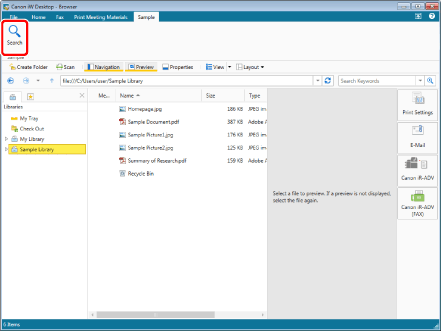
The search screen is displayed.
|
NOTE
|
|
If commands are not displayed on the ribbon of Desktop Browser, see the following to display them.
This operation can also be performed with the tool buttons on the toolbar. If tool buttons are not displayed on the toolbar of Desktop Browser, see the following to display them.
|
2.
Confirm that  (Advanced) is selected.
(Advanced) is selected.
If  (Simple) is selected, click
(Simple) is selected, click  (Advanced).
(Advanced).
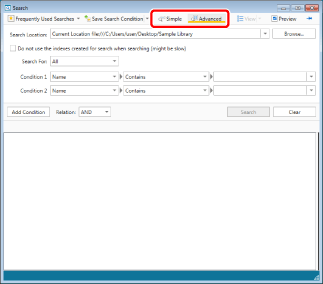
3.
Click [Browse].
In the following cases, proceed to step 5.
To search a library or folder selected in the Navigation Window of Desktop Browser, select [Current Location] from the [Search Location] pull-down list.
To search a library or folder you have previously searched, select the search history from the [Search Location] pull-down list.
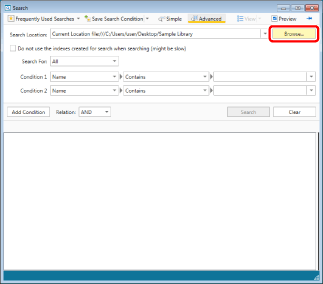
The [Browse] dialog box is displayed.
4.
Select the library or folder to search, then click [OK].
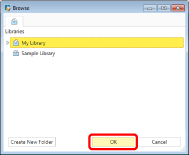
5.
Select the target to search in the [Search For] pull-down list.
|
[All]
|
Searches folders and files.
|
|
[Folders]
|
Searches folders. If you select [Folders], only folder properties can be selected in the search conditions.
|
|
[Files]
|
Searches files.
|
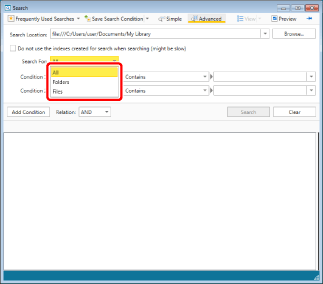
|
NOTE
|
|
Click [Clear] to initialize the search conditions.
|
6.
Select the [Do not use the indexes created for search when searching (might be slow)] check box as necessary.
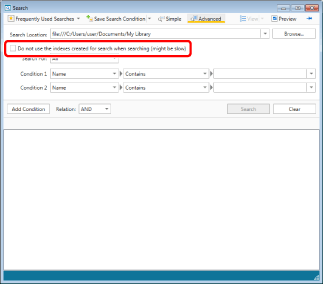
|
NOTE
|
|
For more information on search target differences depending on whether the [Do not use the indexes created for search when searching (might be slow)] check box is selected, see the following.
Library Search Results (Administrator Guide)
If you selected a Network Library (database) to search, the following information is displayed on the bottom of the Search Screen.
[Database Modified Date]:
Displays the date and time that the database was last updated with a periodic update. If a long time has elapsed since the displayed date and time, the content of the database may be old. When searching property information ([Name], [Extensions], [Date Created], [Date Modified], and [Size]), you can select the [Do not use the indexes created for search when searching (might be slow)] check box to search the latest information.
[Number of PDF Documents Whose Index Have Not Been Retrieved]:
Displays the number of documents without annotation text and property information ([Pages] and [Inserted Annotations]) saved in the database. If annotation text cannot be properly searched or the property information is not correctly displayed in the search results, perform the search again after waiting a while so that the number of documents is reduced.
|
7.
In the leftmost pull-down list of the conditional expression, select the properties of the search target.
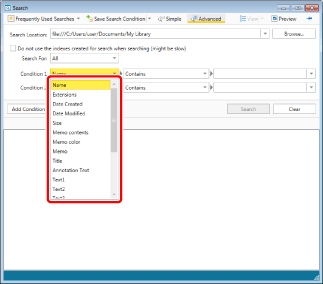
When you search for folders and documents in a Personal Library, the following items can be selected in the leftmost pull-down list.
|
[Name]
|
Sets the document name as the search condition.
|
|
[Extensions]
|
Sets the extension of document as the search condition.
|
|
[Date Created]
|
Sets the year, month, and day that the document was created as the search condition.
|
|
[Date Modified]
|
Sets the year, month, and day that the document was modified as the search condition.
|
|
[Size]
|
Sets the document size in bytes as the search condition.
|
|
[Memo contents]
|
Sets the text in the memo as the search condition.
|
|
[Memo color]
|
Sets the color of the memo as the search condition.
|
|
[Memo]
|
Searches for documents with memos attached.
|
|
[Title]
|
Sets the document title as the search condition.
|
|
[Annotation Text]
|
Sets the annotation text as the search condition.
|
|
[Text1] to [Text5]
|
Sets the property, which is configured as text, as the search condition.
|
|
[Comments]
|
Configures the property, which is configured as comments, as the search condition.
|
|
[Date]
|
Sets the property, which is configured as a date, as the search condition.
|
|
[Value1] to [Value2]
|
Sets the property, which is configured as an integer, as the search condition.
|
|
NOTE
|
|
In the case of a document saved in a library in Advanced Box of imageRUNNER ADVANCE, document search with [Annotation Text] is only possible if the library has been created with annotation text set to be searched.
|
When you search for folders and documents in a Document Server Library, the following items can be selected in the leftmost pull-down list.
|
[Name]
|
Sets the document name as the search condition.
|
|
[Extensions]
|
Sets the extension of document as the search condition.
|
|
[Date Created]
|
Sets the year, month, and day that the document was created as the search condition.
|
|
[Date Modified]
|
Sets the year, month, and day that the document was modified as the search condition.
|
|
[Size]
|
Sets the document size in bytes as the search condition (for documents).
|
|
[Author]
|
Sets the file author as the search condition.
|
|
[Modified By]
|
Sets the user who updated the file as the search condition.
|
|
[Checked Out By]
|
Sets the user who checked out the document as the search condition (for documents.)
|
|
[Version]
|
Sets the document version as the search condition (for documents.)
|
|
[Title]
|
Sets the document title as the search condition (for documents.)
|
|
[Annotation Text]
|
Sets the annotation text as the search condition.
|
|
[Memo contents]
|
Sets the text in the memo as the search condition.
|
|
[Memo color]
|
Sets the color of the memo as the search condition.
|
|
[Memo]
|
Searches for documents with memos attached.
|
|
[Index]
|
Sets the index item configured in the library as the search condition.
|
When you search for folders and documents in a Network Library/Network Library (database), the following items can be selected in the leftmost pull-down list.
|
[Name]
|
Sets the document name as the search condition.
|
|
[Extensions]
|
Sets the extension of document as the search condition.
|
|
[Date Created]
|
Sets the year, month, and day that the document was created as the search condition.
|
|
[Date Modified]
|
Sets the year, month, and day that the document was modified as the search condition.
|
|
[Size]
|
Sets the document size in bytes as the search condition.
|
|
[Annotation Text]
|
Sets the annotation text as the search condition.
You can perform searches in the following libraries and folders.
Network Libraries: Network Libraries that full text searches can be performed on. (You must deselect the [Do not use the indexes created for search when searching (might be slow)] check box.)
Network Libraries (databases): Libraries and folders that are set to be managed with a database.
|
|
NOTE
|
|
In the case of a document saved in a library in Advanced Box of imageRUNNER ADVANCE, document search with [Annotation Text] is only possible if the library has been created with annotation text set to be searched.
For more information on Network Libraries (databases), see the following.
For information on management with a database, see the following.
Setting and Management Range in the Database (Administrator Guide)
To search [Annotation Text] in Network Libraries that full text searches can be performed on, return to step 6 and deselect the [Do not use the indexes created for search when searching (might be slow)] check box.
|
8.
Use the pull-down list in the center of the conditional expression to select the search method.
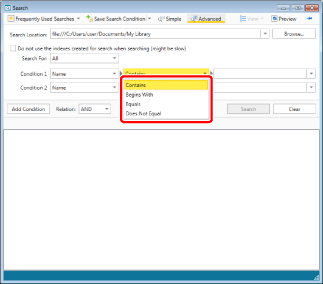
|
[Contains]
|
Searches for items that contain the specified keyword(s).
|
|
[Begins With]
|
Searches for items that begin with the specified keyword(s).
|
|
[Equals]
|
Searches for items that equal to the specified keyword(s).
|
|
[Does Not Equal]
|
Searches for items that do not equal to the specified keyword(s).
|
|
[Is Greater Than or Equal To]
|
Searches for items that contain a file size or extended integer that is greater than or equals to the specified keyword.
|
|
[Is Less Than or Equal To]
|
Searches for items that contain a file size or extended integer that is lesser than or equal to the specified keyword.
|
|
[Is On or Before]
|
Searches for items with a date that is before or equal to the specified keyword.
|
|
[Is On or After]
|
Searches for items with a date that is after or equal to the specified keyword.
|
|
NOTE
|
|
The items you can specify vary depending on the property you select in the leftmost pull-down list.
|
9.
In the rightmost pull-down list of the conditional expression, enter or select search keywords/values.
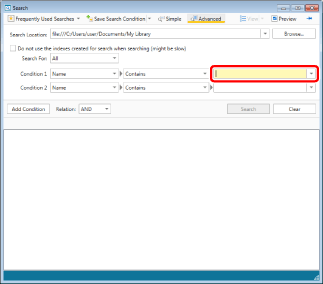
|
NOTE
|
|
For [Extensions], enter without including "." (dot).
For [Date Created] and [Date Modified], enter or select a date in the year/month/date format.
For [Size], enter the file size of the document in bytes.
In the case of an IWB document to which text decoration has been applied, editing or searching text decoration may not be performed depending on characters of text decoration.
|
10.
Add search conditions as necessary.
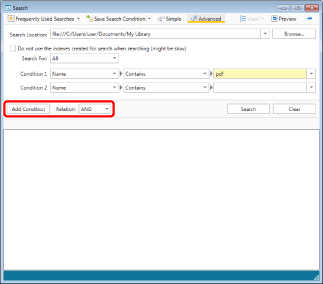
|
NOTE
|
|
You can set up to five conditional expressions. To add a conditional expression, click [Add Condition].
If you set multiple conditional expressions, select [AND] or [OR] in [Relation].
When [AND] is selected, search results that include all the search conditions set in [Condition] are displayed.
When [OR] is selected, search results that include any of the search conditions set in [Condition] are displayed.
|
11.
Click [Search].
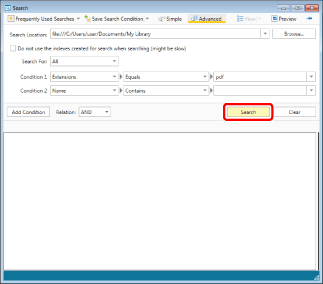
The search results are displayed on the Search Screen.
To pause searching, click [Cancel Search] on the Search Screen.
|
NOTE
|
|
The path of the search target library or folder is displayed in [Search Location] on the Search Screen.
The search results view switches between [Large Thumbnail], [Medium Thumbnail], [Small Thumbnail], and [List] each time you click
You can preview the documents found in the search on the Search Screen. For more information, see the following.
To display the Search Screen always in front of the Desktop Browser screen, click
Documents may not be reflected in the index and search results immediately after they are edited, depending on the timing for updating the index. In this case, try searching again after waiting a while.
When a Network Library (database) is searched for with the [Do not use the indexes created for search when searching (might be slow)] check box selected, information for the following items is only displayed in the search results for documents where the search string was found in the annotation text.
[Inserted Annotations]
[Pages]
You can change the items to display in [Choose Details], which is displayed by right-clicking the header of the search results.
|
Performing Simple Searches
The simple search screen enables you to perform a document full text search or folder/document property information search.
|
NOTE
|
|
To perform a full text search in Desktop, preparation is required.
For information on how to perform full text searches in a Personal Library, refer to the "Installation Guide"
For information on how to perform full text searches of documents/folders in a Network Library that is not managed in a database, see the following
Installing Desktop Index Filter (Administrator Guide)
If you change the display format for dates or numeric values in [Control Panel] > [Clock, Language, and Region] > [Region and language], you need to rebuild indexes to perform searches using the new display format. For more information on how to rebuild indexes ([Control Panel] > [Indexing Options] > [Advanced] > [Rebuild]), refer to the Help for your computer.
For more information on document/folder properties, see the following.
Property searches in the 'property name:search keyword' format made by specifying the properties of the search targets cannot be performed on the simple Search Screen.
|
1.
Click  (Search) on the ribbon.
(Search) on the ribbon.
 (Search) on the ribbon.
(Search) on the ribbon.Or, follow one of the steps described below.
Click  (Start Search) on the simple search bar
(Start Search) on the simple search bar
Click the simple search bar to display the [Search] tab, and then click  (Search)
(Search)
 (Search)
(Search)
The Search Screen is displayed.
|
NOTE
|
|
If commands are not displayed on the ribbon of Desktop Browser, see the following to display them.
This operation can also be performed with the tool buttons on the toolbar. If tool buttons are not displayed on the toolbar of Desktop Browser, see the following to display them.
|
2.
Confirm that  (Simple) is selected.
(Simple) is selected.
If  (Advanced) is selected, click
(Advanced) is selected, click  (Simple).
(Simple).
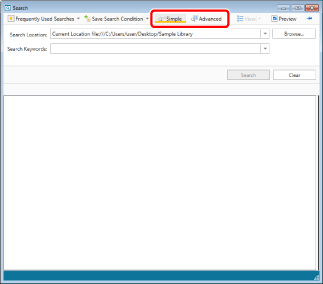
3.
Click [Browse].
In the following cases, proceed to step 5.
To search a library or folder selected in the Navigation Window of Desktop Browser, select [Current Location] from the [Search Location] pull-down list.
To search a library or folder you have previously searched, select the search history from the [Search Location] pull-down list.
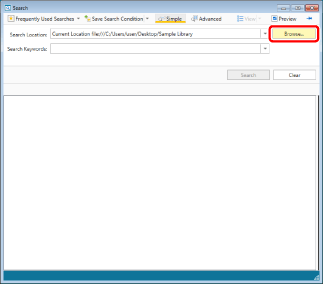
The [Browse] dialog box is displayed.
4.
Select the library or folder to search, then click [OK].
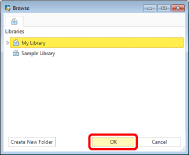
5.
Enter the search keyword.
Or, select a keyword from the keyword list saved in the [Search Keywords] pull-down list.

|
NOTE
|
|
Clicking
You can enter single or double-byte spaces as keyword separators. When a search is executed, search results that include all the separated strings are displayed.
In a document inside a Document Server Library, when using a word which does not make sense as a search keyword (e.g., "a" or "the"), all documents within the search range, including those which do not contain the search keywords, will be displayed.
|
6.
Click [Search].
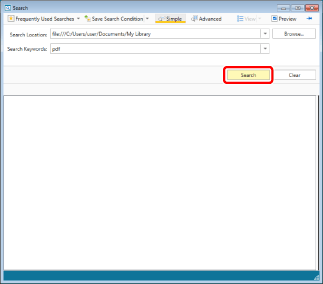
The search results are displayed on the Search Screen.
To pause searching, click [Cancel Search] on the Search Screen.
|
NOTE
|
|
The search results view switches between [Large Thumbnail], [Medium Thumbnail], [Small Thumbnail], and [List] each time you click
You can preview the documents found in the search on the Search Screen. For more information, see the following.
To display the Search Screen always in front of the Desktop Browser screen, click
The path of the search target library or folder is displayed in [Search Location] on the Search Screen.
In the case of an IWB document to which text decoration has been applied, editing or searching text decoration may not be performed depending on characters of text decoration.
If you selected a Network Library (database) to search, the following information is displayed on the bottom of the Search Screen.
[Database Modified Date]:
Displays the date and time that the database was last updated with a periodic update. If a long time has elapsed since the displayed date and time, the content of the database may be old. When searching property information ([Name] and [Extensions]), you can select the [Do not use the indexes created for search when searching (might be slow)] check box to search the latest information.
[Number of PDF Documents Whose Index Have Not Been Retrieved]:
Displays the number of documents without annotation text and property information ([Pages] and [Inserted Annotations]) saved in the database. If annotation text cannot be properly searched or the property information is not correctly displayed in the search results, perform the search again after waiting a while so that the number of documents is reduced.
You can change the items to display in [Choose Details], which is displayed by right-clicking the header of the search results.
|